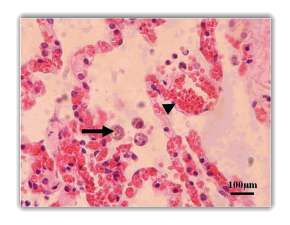The Open Access journal Parasite just published the results on toxoplasmosis in Giant Panda.
In February 2014, China’s Zhengzhou Zoo suffered the loss of a 7-year-old female panda named Jin Yi. The Giant Panda was infected with toxoplasmosis, a disease caused by the protozoanToxoplasma gondii, which infects virtually all warm-blooded animals (mammals and birds), including humans.
Hongyu Ma, Zedong Wang, Chengdong Wang, Caiwu Li, Feng Wei, and Quan Liu, six researchers from the Jilin Agricultural University in Changchun, the Military Veterinary Institute in Changchun and the China Conservation and Research Center for the Giant Panda, Ya’an, China, have now published their analysis, based on immunological and molecular methods. They confirmed that JinYi died from acute gastroenteritis and respiratory symptoms caused by toxoplasmosis.
 Macrophages containing Toxoplasma gondii tachyzoites (arrow) in the alveoli, and dilated capillaries (arrowhead) in the alveolar wall. Giant panda lung, hematoxylin-eosin stain. H. Ma et al.: Parasite 2015,22, 30. Open Access image
Macrophages containing Toxoplasma gondii tachyzoites (arrow) in the alveoli, and dilated capillaries (arrowhead) in the alveolar wall. Giant panda lung, hematoxylin-eosin stain. H. Ma et al.: Parasite 2015,22, 30. Open Access image
Jean-Lou Justine, Editor-in-Chief of Parasite says “This first report of toxoplasmosis in the Giant Panda is a major finding as it is an additional example of the ubiquity of Toxoplasma gondii, a parasite famous for reports of its effects on the behavior of infected mice. To our knowledge, this is the first report of clinical toxoplasmosis in a Giant Panda.”
This paper published in Parasite is available in English with English, French and Chinese abstracts and free to read. Please follow this link, http://dx.doi.org/10.1051/parasite/2015030
















